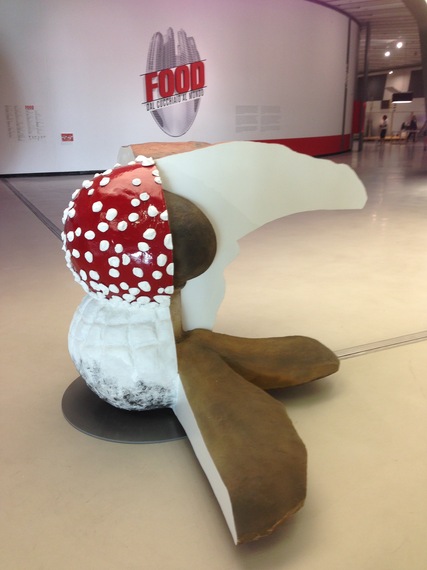By Fabio Parasecoli, Associate professor and coordinator of food studies, The New School.
Not to be outclassed by Milan, where the Expo 2015 – with more or less success – has turned the spotlight on food and nutrition as one on the most urgent issues of our time, Rome has now its own food-themed exhibitions.
A show called Food: dal cucchiaio al mondo (from the spoon to the world) is gracing the gorgeous spaces of MAXXI (the National Museum for the Twenty-first Century Arts) until November 8th. The theme is the relationship between food and space, examined through increasingly wider frames of reference: from the body to the world, and from the home to the street and the city. The exhibition showcases works from artists, photographers, and architects that exemplify the complex role producing, cooking, and eating food play in our lives. Short videos illustrate projects in urban agriculture from Florence to Nairobi, with ample consideration dedicated to the social and political aspects of food systems, as well as to their impact in terms of sustainability. The concept of landscape – and in particular agricultural landscape – emerges as a lens to examine the connection between human communities and their environments, not only in the rural world but also in the growing metropolises around the world.
Rich in content and dealing with extremely complex themes, the MAXXI show is engaging. It avoids excessive abstraction, and parses the information to make it easily accessible to specialists and non-specialists alike. Objects of daily use, architectural sketches and models, as well as pieces created for the exhibition, all guide viewers to look inward at personal daily habits and to consider their place in the food system.
The other show, which will occupy the magnificent structures of the Markets of Trajan, right next to the Imperial Fora, until November 1st, is L’eleganza del cibo: Tales of Food and Fashion. The exhibitions sets to illustrate the interesting and very little explored connections between food and fashion, both primal human needs as well as major domains of consumption and self-expression in contemporary societies. The show is visually stunning, using the architectural spaces and details of the Roman building to highlight dresses, foulards, and accessories from renowned fashion designers that include food (like a dress with transparent pockets full of popcorn) and kitchen tools (notably a necklace that represents spaghetti and a fork). The majority of the pieces, however, simply use fruit, fish, or other ingredients and dishes as motifs in the textile or in the shape of the dresses.
From this point of view, however, the exhibition is a missed opportunity, limiting itself to the surface of both food and fashion without going deeper than their visual aspects. For instance, there is no mention of any attempt to use the leftovers from edible crops as textile materials, or to employ edible, non-toxic dies in the industry. Any reflection on the similarities and differences between food and fashion as global phenomena is absent, as is meaningful dialogue around food and clothing productions as artisanal, utilitarian crafts, often considered inherently removed from high-brow arts.
Decoration, luxury, and necessity are deeply intertwined in both fields, and an exhibition like the one at the Markets of Trajan could have become an opportunity to convey some of these themes to the public in an entertaining and stimulating way. Maybe the desire to preserve the aura of glamour of high fashion, an important sector for the Italian economy, has narrowed the content of the show preventing it from starting more fully developed conversations about material culture in Italy.


Comments are closed.